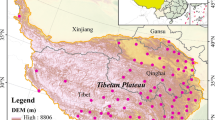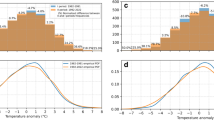Abstract
The global temperature rise is accompanied by an increase in the frequency of extreme weather events, which can lead to significant disturbances in plant metabolic processes and the functioning of plant communities. Depending on the type of vegetation and climatic conditions, the extent and nature of this impact can vary significantly. Therefore, the aim of this work is to identify areas with different types of plant communities that have been most affected by extreme temperatures and precipitation in recent decades. To identify regions with temperature and precipitation extremes, we estimate the frequency at which a given threshold is exceeded (less than 5% quantile or greater than 95% quantile) for selected theoretical probability density functions for the air temperature and precipitation series. The number of cases in which the extreme threshold is exceeded is calculated for the whole globe, and their spatial and temporal variability in different seasons of the year and in the first decades of the 21st century compared to the end of the 20th century is analyzed. Regions with different types of plant communities with the most pronounced amplification of extreme temperature and precipitation regimes under changing climate conditions are identified.




Similar content being viewed by others
REFERENCES
Beck, H.E., Zimmermann, N.E., McVicar, T.R., et al., et al., Present and future Köppen–Geiger climate classification maps at 1-km resolution, Sci. Data, 2018, vol. 5, pp. 1–12.
Beer, C., Reichstein, M., Tomelleri, E., et al., Terrestrial gross carbon dioxide uptake: global distribution and covariation with climate, Science, 2010, vol. 329, no. 5993, pp. 834–838.
Frank, J. and Massey, J., The Kolmogorov–Smirnov test for goodness of fit, J. Am. Stat. Assoc., 1951, vol. 46, no. 253, pp. 68–78.
Frank, D.C., Poulter, B., Saurer, M., et al., Water-use efficiency and transpiration across European forests during the anthropocene, Nat. Clim. Change, 2015, vol. 5, no. 6, pp. 579–583.
Hansen, J., Sato, M., and Ruedy, R., Perception of climate change, Proc. Natl. Acad. Sci. USA, 2012, vol. 109, no. 37.
Hersbach, H., Bell, B., Berrisford, P., et al., The ERA5 global reanalysis, Q. J. R. Meteorol. Soc., 2020, vol. 146, no. 730, pp. 1999–2049.
Lavers, D.A., Simmons, A., Vamborg, F., et al., An evaluation of ERA5 precipitation for climate monitoring, Q. J. R. Meteorol. Soc., 2022, vol. 148, no. 748, pp. 3152–3165.
Lei, X., Xu, W., Chen, S., et al., How well does the ERA5 reanalysis capture the extreme climate events over china? Part I: Extreme precipitation, Front. Environ. Sci., 2022, vol. 10, pp. 1–14.
Li, L., Fan, W., Kang, X., et al., Responses of greenhouse gas fluxes to climate extremes in a semiarid grassland, Atmos. Environ., 2016, vol. 142, pp. 32–42.
Mahecha, M.D., Reichstein, M., Carvalhais, et al., Global convergence in the temperature sensitivity of respiration at ecosystem level, Science, 2010, vol. 329, no. 5993, pp. 838–840.
O’Gorman, P.A., Precipitation extremes under climate change, Curr. Clim. Change Rep., 2015, vol. 1, no. 2, pp. 49–59.
Parmesan, C., Morecroft, M.D., Trisurat, Y., et al., Terrestrial and freshwater ecosystems and their services, in Climate Change 2022: Impacts, Adaptation and Vulnerability, Pörtner, H.-O., Roberts, D.C., Tignor, M., Eds., New York: Cambridge University Press, 2022, ch. 2, pp. 197–377.
Peel, M.C., Finlayson, B.L., and McMahon, T.A., Updated world map of the Köppen–Geiger climate classification, Hydrol. Earth Syst. Sci. Update, 2007, vol. 11, pp. 1633–1644.
Reichstein, M., Bahn, M., Ciais, P., et al., Climate extremes and the carbon cycle, Nature, 2013, vol. 500, no. 7462, pp. 287–295.
Seneviratne, S.I., Zhang, X., Adnan, M., et al., Weather and climate extreme events in a changing climate, in Climate Change 2021: The Physical Science Basis. Contribution of Working Group I to the Sixth Assessment Report of the Intergovernmental Panel on Climate Change, Masson-Delmotte, , Eds., New York: Cambridge University Press, 2021, ch. 11, pp. 1513–1766.
Shapiro, S.S. and Wilk, M.B., An analysis of variance test for normality (complete samples), Biometrika, 1965, vol. 52, nos. 3–4, pp. 591–611.
Smith, M.D., The ecological role of climate extremes: current understanding and future prospects, J. Ecol., 2011, vol. 99, no. 3, pp. 651–655.
Tabari, H., Climate change impact on flood and extreme precipitation increases with water availability, Sci. Rep., 2020, vol. 10, no. 1, pp. 1–10.
Weibull, W., A statistical distribution function of wide applicability, J. Appl. Mech., 1951, vol. 103, pp. 293–297.
Xu, W., Lei, X., Chen, S., et al., How well does the ERA5 reanalysis capture the extreme climate events over China? Part II: Extreme temperature, Front. Environ. Sci., 2022, vol. 10, pp. 1–15.
Zhao, M. and Running, S.W., Drought-induced reduction in global terrestrial net primary production from 2000 through 2009, Science, 2010, vol. 329, no. 5994, pp. 940–943.
Zscheischler, J., Mahecha, M.D., Harmeling, S., et al., Detection and attribution of large spatiotemporal extreme events in Earth observation data, Ecol. Inf., 2013, vol. 15, pp. 66–73.
Zscheischler, J., Mahecha, M.D., von Buttlar, J., et al., A few extreme events dominate global interannual variability in gross primary production, Environ. Res. Lett., 2014a, vol. 9, no. 3.
Zscheischler, J., Michalak, A.M., Schwalm, M.D., et al., Impact of large-scale climate extremes on biospheric carbon fluxes: An intercomparison based on MsTMIP data, Global Biogeochem. Cycles, 2014b, vol. 28, no. 6, pp. 585–600.
Zscheischler, J., Reichstein, M., Harmeling, S., et al., Extreme events in gross primary production: A characterization across continents, Biogeosciences, 2014c, vol. 11, no. 11, pp. 2909–2924.
Funding
This study was carried out with support from the Russian Science Foundation as part of scientific project no. 22-17-00073.
Author information
Authors and Affiliations
Corresponding authors
Ethics declarations
CONFLICT OF INTEREST
The authors declare that they have no conflicts of interest.
ADDITIONAL INFORMATION
This article was prepared on the basis of a poster report presented at the IV All-Russian Conference Turbulence, Atmospheric and Climate Dynamics with international participation, dedicated to the memory of Academician A.M. Obukhov (Moscow, November 22–24, 2022).
Rights and permissions
About this article
Cite this article
Zheleznova, I.V., Gushchina, D.Y. Variability of Extreme Air Temperatures and Precipitation in Different Natural Zones in the Late 20th and Early 21st Centuries According to ERA5 Reanalysis Data. Izv. Atmos. Ocean. Phys. 59, 479–488 (2023). https://doi.org/10.1134/S0001433823050134
Received:
Revised:
Accepted:
Published:
Issue Date:
DOI: https://doi.org/10.1134/S0001433823050134




